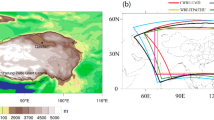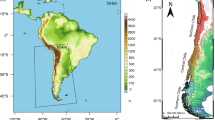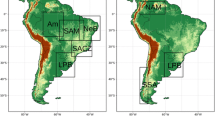Abstract
This study evaluates the UCLA-ETA regional model’s dynamic downscaling ability to improve the National Center for Environmental Prediction Climate Forecast System (NCEP CFS), winter season predictions over the contiguous United States (US). Spatial distributions and temporal variations of seasonal and monthly precipitation are the main focus. A multi-member ensemble means of 22 winters from 1982 through 2004 are included in the study. CFS over-predicts the precipitation in eastern and western US by as much as 45 and 90 % on average compared to observations, respectively. Dynamic downscaling improves the precipitation hindcasts across the domain, except in the southern States, by substantially reducing the excessive precipitation produced by the CFS. Average precipitation root-mean-square error for CFS and UCLA-ETA are 1.5 and 0.9 mm day−1, respectively. In addition, downscaling improves the simulation of spatial distribution of snow water equivalent and land surface heat fluxes. Despite these large improvements, the UCLA-ETA’s ability to improve the inter-annual and intra-seasonal precipitation variability is not clear, probably because of the imposed CFS’ lateral boundary conditions. Preliminary analysis of the cause for the large precipitation differences between the models reveals that the CFS appears to underestimate the moisture flux convergence despite producing excessive precipitation amounts. Additionally, the comparison of modeled monthly surface sensible and latent heat fluxes with Global Land Data Assimilation System land data set shows that the CFS incorrectly partitioned most of surface energy into evaporation, unlike the UCLA-ETA. These findings suggest that the downscaling improvements are mostly due to a better representation of land-surface processes by the UCLA-ETA. Sensitivity tests also reveal that higher-resolution topography only played a secondary role in the dynamic downscaling improvement.














Similar content being viewed by others
References
Betts AK (1986) A new convective adjustment scheme. Part I: observational and theoretical basis. Quart J R Meteorol Soc 112:677–691
Bukovsky MS, Karoly DJ (2009) Precipitation simulations using WRF as a nested regional climate model. J Appl Meteorol Climatol 48:2152–2159
Chan SC, Misra V (2011) Dynamic downscaling of the North American Monsoon with the NCEP—scripps regional spectral model from the NCEP CFS global model. J Clim 24:653–673
Chen M, Xie P, Janowiak JE, Arkin PA (2002) Global land precipitation: a 50-yr monthly analysis based on gauge observations. J Hydrometeorol 3:249–266
Chou SC, Tanajura CAS, Xue Y, Nobre CA (2002) Simulation of the coupled Eta/SSiB model over South America. J Geophys Res. doi:10.1029/2000JD000270
Collini EA, Berbery EH, Barros VR, Pyle ME (2008) How does soil moisture influence the early stages of the South American Monsoon? J Clim 21:195–213
Daly C, Neilson RP, Phillips DL (1994) A statistical–topographic model for mapping climatological precipitation over mountainous terrain. J Appl Meteorol 33:140–158
De Sales F, Xue Y (2006) Investigation of seasonal prediction of the South American regional climate using the nested model system. J Geophys Res. doi:10.1029/2005JD006989
De Sales F, Xue Y (2011) Assessing the dynamic-downscaling ability over South America using the intensity-scale verification technique. Int J Climatol 31:1205–1221. doi:10.1002/joc.2139
Di Luzio M, Gregory LJ, Daly C, Eischeid JK, Arnold JG (2008) Constructing retrospective gridded daily precipitation and temperature datasets for the conterminous United States. J Appl Meteorol Climatol 47:475–497
Druyan LM, Feng J, Cook K, Xue Y, Fulakeza M, Hagos S, Konare A, Moufouma-Okia W, Rowell DP, Vizy EK, Ibrah SS (2010) The WAMME regional model intercomparison study. Clim Dyn 35:175–192
Dyer J, Mote TL (2006) Spatial variability and trends in observed snow depth over North America. Geophys Res Lett 33, L16503. doi:10.1029/2006GL027258
Fels SB, Schwartzkopf MD (1975) The simplified exchange approximation: a new method for radiative transfer calculation. J Atmos Sci 32:1475–1488
Fennessy MJ, Shukla J (2000) Seasonal prediction over North America with a regional model nested in a global model. J Clim 13:605–2627
Gao Y, Xue Y, Peng W, Kang HS, Waliser D (2011) Assessment of dynamic downscaling of the extreme rainfall over East Asia using regional climate model. Adv Atmos Sci 28:1077–1098
Hong SY, Pan HL (1996) Non-local boundary layer vertical diffusion in a medium range forecast model. Mon Weather Rev 124:2322–2339
Hong SY, Pan HL (1998) Convective trigger function for a mass-flux cumulus parameterization scheme. Mon Weather Rev 126:2599–2620
Hou YT, Moorthi S, Campana KA (2002) Parameterization of solar radiation transfer in the NCEP Models. NCEP/EMC Tech Mem 441, p 46
Janjic ZI (1984) Nonlinear advection schemes and energy cascade on semi-staggered grids. Mon Weather Rev 112:1234–1245
Janjic ZI (1994) The step-mountain Eta coordinate model: further developments of the convection, viscous sublayer, and turbulence closure schemes. Mon Weather Rev 122:927–945
Kanamitsu M, Kuma A, Juang HMH, Schemm JK, Wang W, Yang F, Hong SY, Peng P, Chen W, Moorthi S, Ji M (2002) NCEP Dynamical seasonal forecasting system 2002. Bull Am Meteorol Soc 83:1019–1037
Kim J, Miller NL, Farrara JD, Hong SY (2000) A seasonal precipitation and stream flow hindcast and prediction study in the western United States during the 1997/98 winter season using a dynamic downscaling system. J Hydrometeorol 1:311–329
Lacis A, Hansen JE (1974) A parameterization for the absorption of solar radiation in the Earth’s atmosphere. J Atmos Sci 22:40–63
Liang XZ, Li L, Dai A, Kunkel KE (2004a) Regional climate model simulation of summer precipitation diurnal cycle over the United States. Geophys Res Lett. doi:10.1029/2004GL021054
Liang XZ, Li L, Kunkel KE, Ting M, Wang JXL (2004b) Regional climate model simulation of U.S. precipitation during 1982–2002. Part I: Annual cycle. J Clim 17:3510–3529
Mahrt L, Pan H-L (1984) A two-layer model of soil hydrology. Bound-Layer Meteorol 29:1–20
Mellor GL, Yamada T (1982) Development of a turbulence closure model for geophysical fluid problems. Rev Geophys Space Phys 20:851–875
Mesinger F, Janjic ZL, Nickovic S, Gavrilov D, Deaven DG (1988) The step-mountain coordinate: model description and performance for cases of Alpine lee cyclogenesis and for a case of an Appalachian redevelopment. Mon Weather Rev 116:1493–1518
Mesinger F, DiMego G, Kalnay E, Mitchell K, Shafran PC, Ebisuzaki W, Jovic D, Woollen J, Rogers E, Berbery EH, Ek MB, Fan Y, Grumbine R, Higgins W, Li H, Lin Y, Manikin G, Parrish D, Shi S (2006) North American regional reanalysis. Bull Am Meteorol Soc 87:343–360
Pacanowski RC, Griffies SM (1998) MOM 3.0 Manual. NOAA/Geophysical Fluid Dynamics Laboratory. Princeton
Pan Z, Christensen JH, Arritt RW, Gutowski WJ Jr, Takle ES, Otieno F (2001) Evaluation of uncertainties in regional climate change simulations. J Geophys Res 106:17735–17751
Pielke RA Sr, Liston GE, Eastman JL, Lu L, Coughenour M (1999) Seasonal weather prediction as an initial value problem. J Geophys Res 104:19463–19479
Rodell M, Houser PR, Jambor U, Gottschalck J, Mitchell K, Meng CJ, Arsenault K, Cosgrove B, Radakovich J, Bosilovich M, Entin JK, Walker JP, Lohmann D, Toll D (2004) The global land data assimilation system. Bull Am Meteorol Soc 85:381–394
Ruiz-Barradas A, Nigam S (2005) Warm season rainfall variability over the U.S. Great plains in observations, NCEP and ERA-40 reanalyses, and NCAR and NASA atmospheric model simulations. J Clim 18:1808–1830
Ruiz-Barradas A, Nigam S (2006) Great plains hydroclimate variability: the view from North American regional reanalysis. J Clim 19:3004–3010
Saha S et al (2006) The NCEP Climate Forecast System. J Climate 19:3483–3517
Sato T, Xue Y (2012) Validating regional climate model’s downscaling ability for East Asian summer monsoon’s interannual variability. Submitted to Climate Dynamics
Sun S, Xue Y (2001) Implementing a new snow scheme in Simplified Simple Biosphere Model (SSiB). Adv Atmos Sci 18:335–354
Sun SF, Jin JM, Xue Y (1999) A simplified layer snow model for global and regional studies. J Geophys Res 104:19587–19597
Sun WY, Min KH, Chern JD (2011) Numerical study of 1998 late summer flood in East Asia. Asia Pac J Atmos Sci 47:123–135
Waliser DE, Kim J, Xue Y, Chao Y, Eldering A, Fovell R, Hall A, Li Q, Liou K, McWilliams J, Kapnick S, Vasic R, De Sales F, Yu Y (2011) Simulating the Sierra Nevada snowpack: the impact of snow albedo and multi-layer snow physics. Clim Change 109:S59–S117. doi:10.1007/s10584-011-0312-5
Xue Y, Fennessy MJ, Sellers PJ (1996) Impact of vegetation properties on U.S. summer weather prediction. J Geophys Res 101:7419–7430
Xue Y, Zeng FJ, Mitchell K, Janjic Z, Rogers E (2001) The impact of land surface processes on simulations of the U.S. hydrological cycle: a case study of the 1993 flood using the SSiB land surface model in the NCEP Eta regional model. Mon Weather Rev 129:2833–2860
Xue Y, Juang HMH, Li W, Prince S, DeFries R, Jiao Y, Vasic R (2004) Role of land surface processes in monsoon development: part I—East Asia and West Africa. J Geophys Res 109:D03105. doi:10.1029/2003JD003556.PP24
Xue Y, De Sales F, Li WP, Mechoso CR, Nobre CA, Juang HM (2006) Role of land surface processes in South American monsoon development. J Clim 19:741–762
Xue Y, Vasic R, Janjic Z, Mesinger F, Mitchell KE (2007) Assessment of dynamic downscaling of the continental U.S. regional climate using the Eta/SSiB regional climate model. J Clim 20:4172–4193
Xue Y, De Sales F, Vasic R, Mechoso CR, Prince SD, Arakawa A (2010) Global and temporal characteristics of seasonal climate/vegetation biophysical process (VBP) interactions. J Clim 23:1411–1433
Xue Y, Vasic R, Janjic J, Liu YM, Chu PC (2012) The impact of spring subsurface soil temperature anomaly in the Western U.S. on North American summer precipitation—a case study using regional climate model downscaling. J Geophys Res 117:D11103. doi:10.1029/2012JD017692
Yang K et al (2007) Initial CEOP-based review of the prediction skill of operational general circulation models and land surface models. J Meteorol Soc Jpn 85A:99–116
Zhao Q, Carr FH (1997) A Prognostic cloud scheme for operational NWP models. Mon Weather Rev 125:1931–1953
Acknowledgments
This study was funded by the National Oceanic and Atmospheric Administration under the grants NA08OAR4310591 and NA07OAR4310226, and by the National Science Foundation under the grants AGS-1115506 and ATM-0751030. The authors thank the Multi-RCM Ensemble Downscaling of Multi-GCM seasonal forecasts (MRED) project for providing the CFS model results. All the UCLA-ETA model runs were carried out at the National Center for Atmospheric Research’s computers.
Author information
Authors and Affiliations
Corresponding author
Rights and permissions
About this article
Cite this article
De Sales, F., Xue, Y. Dynamic downscaling of 22-year CFS winter seasonal hindcasts with the UCLA-ETA regional climate model over the United States. Clim Dyn 41, 255–275 (2013). https://doi.org/10.1007/s00382-012-1567-x
Received:
Accepted:
Published:
Issue Date:
DOI: https://doi.org/10.1007/s00382-012-1567-x




